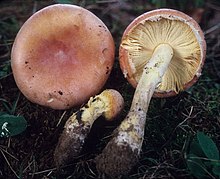Amanita wellsii
| Amanita wellsii | |
|---|---|

| |
| Scientific classification | |
| Kingdom: | Fungi |
| Division: | Basidiomycota |
| Class: | Agaricomycetes |
| Order: | Agaricales |
| Family: | Amanitaceae |
| Genus: | Amanita |
| Species: | A. wellsii
|
| Binomial name | |
| Amanita wellsii (Murrill) Murrill (1920)
| |
| Synonyms | |
| |
Amanita wellsii or the salmon amanita[1] is a species of agaric fungus in the family Amanitaceae. It was described by American mycologist William Alphonso Murrill in 1920, based on collections made in Springfield, New Hampshire in 1917. The specific epithet honors Professor H. L. Wells, who had previously studied the species.[2]
The fungus is found in North America with a range extending from the Appalachian Mountains (North Carolina) north to the limit of the distribution of alder in Canada.[3] Fruit bodies grow scattered or in groups on the ground in mixed forests. The edibility of A. wellsii mushrooms is unknown.[4]
See also[]
References[]
- ^ "Standardized Common Names for Wild Species in Canada". National General Status Working Group. 2020.
- ^ Murrill, W.A. (1920). "A new Amanita". Mycologia. 12 (5): 291–292. JSTOR 3753195.
- ^ Tulloss, R. "Amanita wellsii". Amanitaceae.org. Retrieved 2014-01-18.
- ^ Bessette, A.; Miller, O.K. Jr; Bessette, A.R.; Miller, H.R. (1995). Mushrooms of North America in Color: A Field Guide Companion to Seldom-Illustrated Fungi. Syracuse, New York: Syracuse University Press. pp. 6–7. ISBN 0-8156-2666-5.
External links[]
Categories:
- Amanita
- Fungi of North America
- Fungi described in 1920
- Taxa named by William Alphonso Murrill
- Amanitaceae stubs